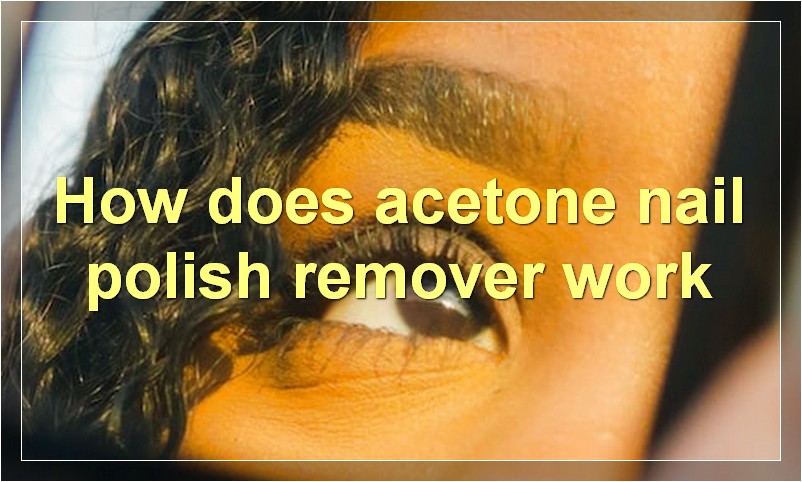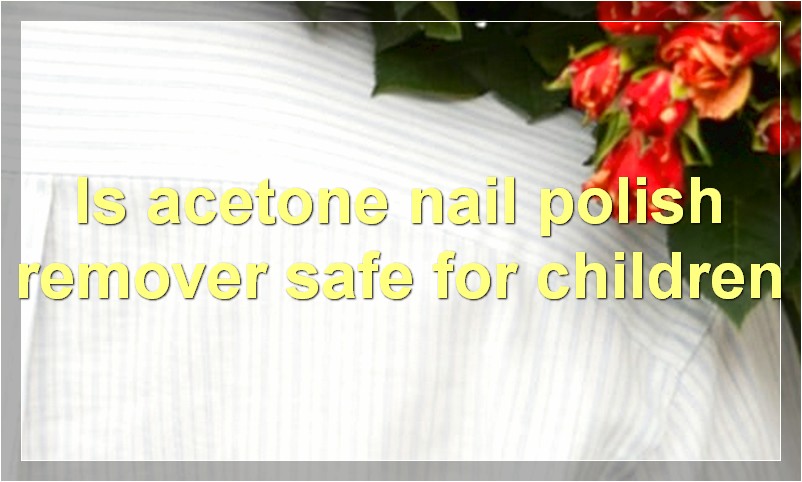Acetone nail polish removers are widely used because they are effective and affordable. However, there are some risks associated with using these products.
What are the benefits of using acetone nail polish remover
There are many benefits of using acetone nail polish remover. Acetone is a powerful solvent that can quickly remove nail polish, even old and stubborn nail polish. Acetone nail polish remover also doesn’t leave behind any oily residue, so your nails will feel clean and refreshed after using it.
Acetone is also very effective at removing artificial nails, gel nails, and acrylic nails. If you’ve ever had trouble removing fake nails, then acetone nail polish remover is a godsend. Simply soak a cotton ball in acetone and hold it against your artificial nail for a few minutes. The acetone will dissolve the adhesive that is holding the fake nail in place, and you’ll be able to easily remove the fake nail.
If you have gel nails or acrylic nails, the process is slightly different. You’ll need to file away the top layer of the gel or acrylic nail before you can soak it in acetone. This will help the acetone to penetrate the gel or acrylic and break it down so that you can remove it more easily.
So, if you’re looking for a powerful and effective nail polish remover, acetone is the way to go. It’s fast-acting, gentle on your nails, and doesn’t leave behind any pesky residue. Give it a try next time you need to remove your nail polish!
How does acetone nail polish remover work

Acetone is a powerful solvent that can remove even the toughest of stains. When it comes to removing nail polish, acetone is the go-to choice for many people. But how does it work?
Acetone breaks down the molecules that make up nail polish, allowing it to be easily removed from the nail surface. It’s important to note that acetone is a very strong solvent and should be used with caution. If used incorrectly, it can damage the nails.
When removing nail polish with acetone, be sure to use a cotton ball or pad to avoid contact with the skin. Also, be sure to ventilate the area well as the fumes can be overwhelming.
How do you use acetone nail polish remover
Acetone is a popular choice for removing nail polish because it is relatively inexpensive and works well. However, acetone can also be drying to the nails and skin, so it is important to use it sparingly and to moisturize the nails and skin afterwards. Here are some tips for using acetone nail polish remover:
-Start by soaking a cotton ball in acetone.
-Gently press the soaked cotton ball onto your nail for a few seconds, then swipe it off.
-Repeat this process until all of the nail polish has been removed.
-Once you’re finished, wash your hands with soap and water to remove any residue and moisturize your nails and skin.
What are the side effects of using acetone nail polish remover
When it comes to acetone nail polish remover, there are a few things you should know. First and foremost, acetone is a powerful solvent that can cause serious damage to your nails if used too frequently. Secondly, while acetone will remove your nail polish quickly and easily, it can also dry out your nails, leaving them vulnerable to breakage.
So, what are the side effects of using acetone nail polish remover? Let’s take a look:
1. Dryness and brittleness: Acetone nail polish remover can cause your nails to become dry and brittle. This is because acetone strips away the natural oils from your nails, leaving them unprotected and susceptible to damage. If you use acetone nail polish remover on a regular basis, you may notice that your nails become thin, flaky and weak. In extreme cases, prolonged exposure to acetone can even lead to nail deformities.
2. Allergic reactions: Some people may be allergic to acetone, which can cause redness, swelling and itchiness around the cuticles. If you experience any of these symptoms after using acetone nail polish remover, discontinue use immediately and consult a doctor.
3. Irritation: Acetone nail polish remover can also cause irritation to the skin around your nails. This is usually the result of contact dermatitis, which occurs when the chemicals in the remover come into contact with your skin. If you experience any irritation or discomfort after using acetone nail polish remover, stop using it immediately and wash the affected area with soap and water.
4. Nail damage: As we mentioned earlier, acetone is a powerful solvent that can cause serious damage to your nails if used too frequently. Prolonged exposure to acetone can make your nails dry, brittle and weak, and can even lead to nail deformities. If you notice any changes in your nails after using acetone nail polish remover, discontinue use immediately and consult a doctor.
5. Eye irritation: If you get acetone nail polish remover in your eyes, it can cause irritation and redness. To avoid this, always wear gloves when using acetone-based products and be sure to keep them away from your face. If you accidentally get some in your eyes, flush them out immediately with water and seek medical attention if the irritation persists.
As you can see, there are a few potential side effects of using acetone nail polish remover. However, these risks can be minimized by taking a few simple precautions. For example, always use gloves when handling acetone-based products and be sure to keep them away from your face and eyes. Additionally, limit your exposure to acetone by using it only as needed and avoiding prolonged exposure. Finally, if you notice any changes in your nails after using acetone nail polish remover, discontinue use immediately and consult a doctor.
Is acetone nail polish remover safe for pregnant women
Acetone is a clear, colorless liquid that is used as a solvent for cleaning purposes. It is also used as a nail polish remover. Acetone is found in many household products such as paint thinners, fingernail polish removers, and some types of cleaners.
Exposure to high levels of acetone may cause irritation of the eyes, nose, and throat. It can also cause dizziness, headache, nausea, and loss of consciousness. Prolonged exposure to acetone can damage the liver, kidneys, and central nervous system.
Pregnant women should avoid exposure to acetone. Exposure to acetone during pregnancy can cause developmental defects in the fetus. There is also a risk of miscarriage and premature birth. If you are pregnant and must use products containing acetone, wear gloves and a mask to avoid inhaling the vapors.
Is acetone nail polish remover safe for children

When it comes to acetone nail polish remover, the jury is still out on whether or not it is safe for children. Some studies have shown that it can be harmful to children, while other studies have found no evidence of harm.
So, what’s the verdict? Is acetone nail polish remover safe for children or not?
At this point, there is no definitive answer. However, if you are concerned about the potential risks, there are some simple steps you can take to protect your child.
First, make sure that the acetone nail polish remover is out of reach of children. Store it in a high cabinet or in a locked box.
Second, don’t let your child use acetone nail polish remover unless supervised by an adult.
Third, avoid using acetone nail polish remover on damaged nails or skin. If you must use it, be sure to apply a protective barrier such as petroleum jelly first.
Fourth, consider using non-acetone nail polish removers instead. These products are generally considered to be safer for children.
Ultimately, the decision of whether or not to use acetone nail polish remover is up to you. If you have any concerns, it is best to err on the side of caution and avoid using it altogether.
Are there any alternatives to acetone nail polish remover
If you’re looking for an alternative to acetone nail polish remover, you’re in luck. There are a few different options on the market that can get the job done without harsh chemicals.
One option is to use a product that contains ethyl acetate. This ingredient is derived from plants and is less harsh on the nails than acetone. Products that contain this ingredient may take a little longer to work, but they’ll be gentler on your nails in the process.
Another alternative is to use a non-acetone nail polish remover. These products typically use ingredients like ethanol or propylene carbonate to dissolve nail polish. They’re not as effective as acetone-based removers, but they’re much gentler on the nails.
Finally, you can always opt for natural solutions like lemon juice or vinegar. These household staples can help break down nail polish without harsh chemicals. Just be prepared to do a little extra scrubbing to get the job done.
No matter which route you choose, ditching acetone is a good way to protect your nails from excessive drying and damage. So, go ahead and experiment with some of these alternative options until you find one that works best for you.
How do you dispose of acetone nail polish remover
When it comes to acetone nail polish remover, there are a few things you need to know in order to dispose of it properly. For starters, acetone is classified as a volatile organic compound (VOC), which means it can easily evaporate into the air. In fact, acetone has been found to be one of the most commonly detected VOCs in indoor air.
While the evaporation of acetone into the air is not necessarily harmful, it can be if there are high concentrations of it. This is why it’s important to ventilate any area where you’re using or disposing of acetone nail polish remover.
Acetone nail polish remover can also be harmful if ingested, so it’s important to keep it out of reach of children and pets. If you must use it indoors, be sure to do so in a well-ventilated area.
So how do you dispose of acetone nail polish remover? The best way is to pour it into a container with a tight-fitting lid and then place that container in the trash. You can also take it to a hazardous waste facility for proper disposal.
What should you do if you accidentally spill acetone nail polish remover
If you accidentally spill acetone nail polish remover, there are a few things you should do. First, try to contain the spill by blotting it with a paper towel or clean cloth. Once you have contained the spill, slowly and carefully pour warm water over the area to dilute the acetone. Then, use a wet vacuum to remove the water and acetone mixture. Finally, clean the area with a mild soap and water solution.
What are some tips for using acetone nail polish remover
When it comes to acetone nail polish remover, there are a few things you need to keep in mind. First and foremost, be sure to use gloves when handling the product. Acetone is a strong chemical and can cause skin irritations. Secondly, always use acetone in a well-ventilated area. The fumes from the product can be overwhelming and cause respiratory problems. Lastly, be careful when using acetone near open flames. The chemical is highly flammable and can cause serious fires.
With those safety tips in mind, here are a few tips for using acetone nail polish remover:
1. Pour a small amount of acetone into a bowl or container.
2. Soak your nails in the acetone for a few minutes.
3. Use a cotton ball or Q-tip to remove the nail polish from your nails.
4. Rinse your nails with soap and water to remove any residue.
5. Apply lotion to your hands to moisturize your skin.





